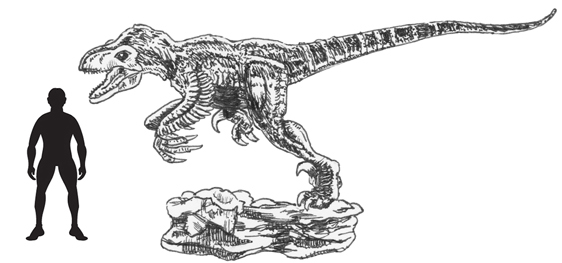Scientists Report on Car-sized Raptor
The Hell Creek Formation of North America has provided scientists with fossils of some of the most iconic dinosaurs known. These ancient sediments were once home to dinosaurs such as Triceratops and Tyrannosaurus rex, however, amongst the many thousands of fossils excavated from these Upper Cretaceous rocks, there were a number of large teeth, unmistakably from a huge dromaeosaur (raptor), but no bones associated with them to provide a description. All that has changed with the publication of a paper in the academic journal “Kansas University Paleontological Contributions”.
Dakotaraptor steini
Terror of the Late Cretaceous of North America
Picture credit: Emily Willoughby
A team of scientists drawn from a number of top American institutions along with professional fossil collectors from the Black Hills Institute of South Dakota have described the partial and very fragmentary skeleton of a super-sized dromaeosaurid dinosaur that once co-existed with the likes of Triceratops and T. rex, sixty-six million years ago. The fossils, including front limb bones and a huge, sickle-shaped toe claw were found in Harding County, South Dakota.
This dinosaur has been named Dakotaraptor steini. Although, less than ten percent of the skeleton has been excavated, comparisons made between these bones and the fossils of more complete raptors such as the famous Velociraptor, suggest that Dakotaraptor measured more than five and half metres in length. This makes it one of the largest dromaeosaurids known and the second largest from North America. Only Utahraptor, a meat-eating dinosaur that roamed Utah some fifty million years or so before Dakotaraptor evolved, was bigger.
Utahraptor – A Scale Drawing
Picture credit: Everything Dinosaur
The Hell Creek Ecosystem
The research team, led by Robert DePalma (Curator of Vertebrate Palaeontology at the Palm Beach Museum of Natural History (southern Florida), have speculated on where in the Hell Creek ecosystem, this agile predator may have fitted, after all, the apex predator was Tyrannosaurus rex. It has been suggested that Dakotaraptor may have been a pack hunter and preyed on other types of herbivore and so it may not have been in direct competition with the tyrannosaurs.
Important Skeletal Features Preserved
Described as being about the size of the “raptors” that featured in the Summer blockbuster “Jurassic World”, Dakotaraptor preserves two very intriguing anatomical features on its bones. Firstly, there is the enormous sickle-shaped claw on the second toe. It measures sixteen centimetres in length, but when the sweeping curvature of the outer curve of the claw is considered, the claw measures an impressive twenty-four centimetres in length. That’s roughly the same size of the toe claw found in the much larger Utahraptor.
In addition, the ulna (bone in the forearm), preserves fifteen large and distinct ulnar papillae (quill knobs). These depressions in the bone are the places of attachment for big, pennaceous feathers. Dakotaraptor is the largest known dinosaur which had wing feathers.
A spokesperson from Everything Dinosaur commented:
“Fossil teeth had indicated that within the Hell Creek Formation strata, evidence for a substantial dromaeosaurid would be found. This fascinating discovery adds another dimension in terms of niche partitioning to the fauna of this part of North America during the Late Cretaceous.”
The Beasts of the Mesozoic range contains a large number of articulated dromaeosaurid models. To view the range: Beasts of the Mesozoic Models and Figures.



